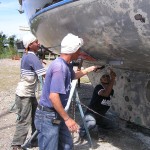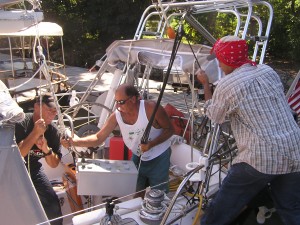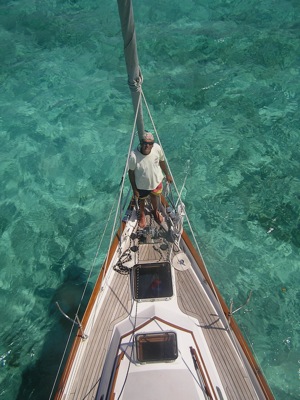
Originally Published in Blue Water Sailing, Fall 2008 or Spring 2009 (I can’t remember), Author: Jan Irons.
******
After 10,000 miles cruising the Western Caribbean aboard our 1985 Passport 37, Winterlude, here are seven things we wish we had known before leaving the U.S.
1. Blisters can happen anytime, Barrier Coat!!! In October 2004, we hauled for one last coat of Micron CSC bottom paint prior to adventuring into the Western Caribbean. We were advised to add a barrier coat, but Winterlude had never developed a single blister in 19 years! Why would we go to the extra time and expense? After spending one hurricane season in the Rio Dulce, Guatemala, we hauled for bottom paint at the LaCeiba Shipyard, mainland Honduras. Imagine our dismay to find the bottom sprouting a vicious crop of blisters. The LaCeiba Shipyard crew told a tale of woe – almost every boat coming out of the Rio has blisters whether or not they had blisters prior to spending hurricane season. Despite scientific confirmation, the warm fresh water apparently contributes to blisters. Had we known this prior to leaving the U.S., we certainly would have endured the extra time & expense to apply a barrier coat! When leaving the U.S., carefully consider the advantages of a barrier coat, even if you’ve never had blisters!
Also, if you prefer a specific bottom paint, take it with you – or realize in many countries you will be forced to select from whatever happens to be available locally. Our original white bottom paint had to be sacrificed for ANY bottom paint in Honduras!
2. Oil changes leave you slimy? Address annoyances before leaving! Annoyances in the U.S. tend to become major problems in paradise! Aboard Winterlude, the inaccessibility of the diesel made an oil change a full day event … if we were lucky. We struggled through many options beginning with a “blue can” suction oil change that never worked properly. The last straw was our decision to emulate the LaCeiba Shipyard’s high tech way to change our oil – 2 gallon baggies under the engine. Unfortunately our baggie had a mind of it’s own. Oil was literally everywhere, draining into the bilge despite our frantic efforts to stop it … covering David, which was actually humorous if it hadn’t been such a disaster. Imagine the mess that we had trying to get quarts of oil out of the bilge & disposed of correctly! Years later we are still dealing with complications from that catastrophe. These days we use an inexpensive electric pump to pump the oil out of the dip stick – originally we avoided anything electric. ANY little “hassle” you have will only get worse after you are cruising in paradise!
3. Take half as much food & twice as many spares! Believe it … you can buy food outside the U.S. For us, half the fun of cruising is shopping in local markets, finding what is available and improvising. Supplementing our food supply with fresh fish is a highlight! I will never understand boats that fill their storage space with provisions from home. Enjoy your adventure!
In case you’re worried about what to do with all that extra space you’ll have by not stocking up on all your favorite foods from the U.S., we have a solution! We debated the necessity of allocating the storage space (and expense) for a fairly comprehensive stock of spares, but they become more essential as the months go by. We planned backup systems for as many critical systems as we could anticipate. On any boat, it’s only a matter of time until everything fails – and older boats may be more prone than most! Cruising the Western Caribbean, replacement parts are not easily available or even accessible via shipping. When lightning struck across the bay in the Rio Dulce, we were happy to have a replacement regulator, echo charger & charge controller. Shipping to Guatemala is almost nonexistent because of the tendency of packages to vanish. Lots of parts are unavailable. If you don’t have a true engine manual, get one. Locals are innovative by necessity!

4. How much juice? Carefully consider how you generate the amps for your systems and multiple by two! If you are redoing your electrical system, it may be wise to use wet cells. We thought we had an adequate battery bank when we left the U.S. but increased it by 70% when we replaced batteries. Outside of the U.S., gel cells or AGM batteries are unavailable, so when our gel cells failed to hold a charge, we had to reconfigure our system to wet cells. Unfortunately, we didn’t change our TrueCharge40 battery charger, so charging still takes forever despite wind, solar and portable generator amps. Don’t make our mistake, if you upgrade your systems, upgrade your battery charger!
Refrigeration especially consumes more amps in the tropics but your entire boat will likely consume more amps than normal. Older boats often need extra insulation for the refrigerator box. One of the best last minute investments we made while waiting for weather to cross to Isla Mujeres was to purchase a small gas powered Honda generator. Despite having both solar & wind generated amps, there are always times when the little generator is worth its weight in gold … as evidenced by numerous attempts by other cruisers to buy ours!
5. Planning to leave your boat? If you’re thinking of leaving your boat and returning to the U.S., plan for ventilation and how to deal with mold and mildew. We bought a dehumidifier before leaving because our plan was to cruise for six months and leave the boat in a marina for hurricane season. We bought a relatively expensive stainless steel version that drains into the sink. After enduring frequent power failures in every marina we’ve left Winterlude, we are convinced some of the best money we spent was on that dehumidifier. Most dehumidifiers trip and shut off when the power blips or goes off – and don’t automatically turn themselves back on. If you don’t have a caretaker watching after EVERY power blip, you can end up with a moldy boat despite having a dehumidifier! Ours automatically restarts anytime the power resumes, so no worries!
Our dehumidifier is another piece of equipment that other cruisers are constantly trying to buy from us!

6. Here Kitty Kitty Kitty …. Have a favorite family pet? Mac, our Himalayan kitty was 13 years old when we began cruising more than just weekends. One of us really wanted Mac to come with us … he’d lived with me all his life! On the other hand, he was an indoor kitty, long haired with no front claws. Heaven only knows if he could swim. Leaving Mac with our daughter proved to be the right decision for us. I miss cuddling up with Mac while I read a good book and a dog can be one of the best ways to safeguard your boat, but before you move Buster aboard please think through the consequences … What kind of cruiser are you? Do you intend to leave the boat while you travel inland to experience more of the culture? Pets are frequently not welcome in hotels and restaurants. Who will take care of Buster while you explore the ancient ruins and colorful market in Antigua, Guatemala? Like us, do you want to cruise six months and live in the U.S. during hurricane season? Bringing a pet back & forth requires special vaccinations, airline hassles (sometimes when you arrive at the airport they don’t honor what they told you on the phone, despite having confirmed it twice!) in addition to the stress on the animal. And we haven’t taken into consideration daily living, taking the dog ashore, getting adequate exercise and how well they deal with heat in the tropics. On the other hand, I thoroughly enjoy playing with other people’s pets aboard their boats, so keep them coming!
7. Creature comforts … Older boats are often missing equipment such as screens. Before leaving the U.S., we were beginning to think the investment we made in good screens was a waste of money. Once in paradise, abundant mosquitos convinced us otherwise! Many anchorages at sunset and sunrise are smothered with mosquitos – David once was the unwilling recipient of 8 mosquito bites at dusk in the time it took us to anchor! Mangrove anchorages tend to be the worst. Unfortunately those anchorages are the very ones that are safest in a norther or bad weather. Even more unfortunately, the night before the norther hits, there will be no breeze to assist in keeping the mosquitos at bay. Make sure your screens are in good shape & do not forget the companionway!
While a watermaker is not essential to cruising, it makes life easier. We enjoy anchorages away from the beaten path where water is often the limiting factor for boats without watermakers. We failed to anticipate other ways the watermaker helps … for example, we snorkel & spearfish almost daily. Daily, our skins, fins, masks and snorkels get a rinse with fresh water allowing them to last longer than those without access to a fresh water rinse (and they smell better too!). With an older boat, you likely will have to forgo some vital space if you decide to add a watermaker. The only space on Winterlude was under the galley sink … space that I thought I needed for pots and pans. Now I rarely miss the pans, but I LOVE having adequate fresh water. A fresh water shower daily (not a combo or just a rinse), is worth another weight in gold!
Even if you have a watermaker, engineer your own water catching system … no sense wasting all that fresh rainwater when it’s relatively easy to catch! PVC pipe and canvas are easy to buy here, but not as easy when you don’t have a car … or a convenient place to buy the materials. Six inches of rain in our dinghy overnight is not a rare occurrence. We simply dam up the sidedecks after the rain rinses off the salt and have filled both tanks on occasion but our system leaves a lot to be desired.
The same rains that provide easy amp-free water also makes it difficult to leave hatches or portholes open. We juryrigged canvas that fits close enough to our main hatch to allow keeping it open in all but sideways wind driven rains. Monsoons can last for days, so be ready! Also consider how your portholes are designed. The briefest downpour leaves our portholes with a puddle which, when opened later, tends to drain directly onto my bed when I’m not being careful. This year we’re trying awnings made of clear flexible plastic cutting boards –we’ve cut them to the exact size of the hatch & they shield the porthole from puddles, we hope!
Equally important on an older boat is insuring you have adequate shade – inspect those biminis/dodgers and sunshades to maximize protection from the sun. A shaded boat can easily be several degrees or more cooler in the tropical sun.
Thinking through the small details will insure that you can re-engineer whatever you need to add to your boat to make cruising in paradise feel like paradise, not just fixing things in exotic places!














We just found your FB page and web site and love it! We’re new to the cruising world and just getting started … great info!
Welcome Aboard! If there are topics you’d like to see covered, let us know & if we don’t know, we’ll pick some of our cruising friends brains! THX! Jan
What is the brand of SS dehumidifier you use? our ole behomoth that is SO noisy! Thanks. Have a good one.
Hi Candy! JPB Dryaire DH5. We got it from Tropica Boats & Marine in Ft Myers, FL in 2003 — I can’t find the dehumidifier online, but maybe a dealer would know more. Good luck!
Layton Matus…
Thanks again for the blog.Really looking forward to read more. Really Great….
Thanks for sharing. Great info.
Thanks for sharing, there are many things to do before cruising.
Jan,
I recently bought a Reverse Osmosis system from Cruisers RO, run by a guy called Rich Boren who makes the boat show ’rounds. The system is GREAT. It all fit in under a bunk, and the darn thing pumps out 20 gallons per hour of the sweetest tasting water ever.
I never thought I’d like a piece of tech on my boat so much. And, I don’t think twice about rinsing my dive gear now. I even wash the deck off with fresh water, just like a big power boat!
Mike
sv “Gypsy Wind”
Marina Del Rey, Calif
Dear Jan and David: Your site came to my computer some days ago and i have found your writings very useful for my project which is…..yeah you guessed it !!! I’m getting a sailboat because I want to sail into the sunset (??) As cheesy as it sounds this story goes to where I live…Cartagena, Colombia…. my background…..marine engineer, citizenship….both Colombian and American. To shorten my story…..I’m selling a piece of property I have and will buy a sailboat, most likely in USA (Ft. Lauderdale area)….I’ve been planning this project for six years. Why am I writing to you ? First to congratulate you for sharing with people your experiences and tips and second , if you deem worthwhile, to have a new contact in Cartagena who is reliable and equally in love with the sea. I’m 64, ex- Colombian Navy officer and looking forward to have a cup of coffe with you guys one of these days. Jus in case my phone 3188417887 buen viento y buena mar !!! NOTE: Im not crazy
Hi German! We LOVE your country! Some of our very favorite cruising! We’d love to share a cup of coffee someday! HAPPY NEW YEAR & Cheers! Jan & David
Hi Jan and David,
Enjoy your blog and the provisioning list especially. Andy and I are leaving Key West in
late January to head to the Berry Islands first and on to where the wind takes us. Your good info is appreciated. Happy New Year.
Sue
s/v Happy Ours
Thanks Sue! Maybe we’ll run into you over there …. for the first winter ever, we’re going wherever the wind blows us! Should be interesting. Hoping to get the boat off the hard (bottom drying, blister repair and bottom paint) and back into the water this week!
Good morning Jan
Thank you for your website and FB.
I received your Cookbook for a Xmas gift this year. Fantastic !!!!
My partner and I just started our 5 year plan, June 2012. We left Georgian Bay, Ontario, and travelled out the St. Lawrence to Shediac, New Brunswick. Our 30 ft. sailboat is on the hard there, until our return this June 2013. We will then be exploring the Maritimes, and then heading down the ICW, Bahamas, and hopefully the Caribbean.
Thank you for all your advise.
Yvonne and Joe
Great, Yvonne! Your adventure sounds wonderful! We’ve never ventured that far north, but I hear it’s wonderful cruising. Hopefully someday we’ll share an anchorage and can enjoy sunsetters together! Cheers! Jan
We are getting ready to Live the Dream in two years. This is the best website I have found for all those things you may never think about. Keep up the great work. My wife and I love it.
For those interested the Dehumidifier, do a search for, Mermaid Marine Grade Dehumidifiers.
Thanks Chuck! I’ll keep a note to let people know Mermaid Marine Grade Dehumidifiers! When I’m asked, I rarely know since we bought ours so long ago! Cheers! Jan & David
Thanks for the blister article. Sharing the same info, when I bought our boat 16 years ago, there were blisters everywhere. Patched and filled over 500 of them. Fast forward 7 years later, we had the boat in the Sea of Cortez for a year and then came back to a ‘fresh’ water harbor. In three months we had 1000s of blisters. Once the surface resins breakdown and get saturated with salt, putting the boat in anything of a lower salinity will create the blisters. To make right, you have to remove the salt from the resin before applying a barrier coat. Just try drying out a shirt rinsed in saltwater –it will not dry. Our boat was freshwater peeled –removing the sacrifice ‘fairing’ layer designed by the manufacture– which allowed the hull to be bone dry in a matter of days. Then on top a new sacrifice layer was resin applied, a hot applied barrier coat / signal coat on top of that, then all new bottom paint. That’s been about 8 years ago and we are now getting our second bottom paint application. The signal coat of white is helpful in showing when it is time to repaint, and the contrasting color also helps us known when the barrier coat is starting to fail.
Happy Sailing…
This is a wonderful entry, you made it enjoyable to read.
WOW! great blog! Both you and your commenting readers are full of good advice. I have sailed for 40 years, but never spent more than ten days aboard. Short cruises in fresh water, the Mississippi and the Great Lakes. Planning to sell all and live aboard Ragtime, and know I have a lot to learn. I have a vast knowledge of boats and boating, but am learning a lot about cruising by reading this blog. Thanks for your help!
Welcome Aboard Don! Thanks for the comments! I’m jealous that you’re just getting ready to leave aboard Ragtime! Hopefully we’ll see you in an anchorage somewhere & share sunsetters! Enjoy! Cheers! Jan
As we enter the cruising world, I found your article informative. I’ve read a lot of this before, but I am left to wonder what you bought.
Specifically what did you use for your oil change pump, your watermaker, and your dehumidifier? You said they were great, but left out that key piece of info 🙂
Thank you for taking the time to write this, you are performing a public service for us newbies…
Matt
Hi Matt — here’s a post with a reference to the oil change pump we’re using these days, no more muss & fuss, just basic utility, but it works. http://commutercruiser.com/how-to-remove-water-from-unexpected-places/ ;Our watermaker is a Spectra Catalina 300, 13 gph, I’m sure I have some posts on it, but can’t think of one off the top of my head. We debated between the Village Wonder watermaker (?) and the Spectra and we’re happy with the Spectra, again, it just works. Our dehumidifier? A bit more trouble, not sure you can buy them anymore, but here’s the info … http://commutercruiser.com/which-dehumidifier-for-a-boat/ ; a friend bought one at a marine swap sale last winter, so keep your eyes out. This post tells you the features to look for and why. Cheers! Jan
Fantastic post. Many thanks.
Here’s some more interesting tidbits about blisters. Yes, they’re much worse in freshwater. They say that if you put on a barrier coat, you have to use this special instrument to measure the moisture content of the hull. Well, when I was reworking my Pearson Flyer, I had the bottom sand blasted, then ground out each blister so that it was indented, then it sat in the dry winter climate for several months. During that time, I watered it to pull out any additional by-product that happens when the water reacts to the resin, and then didn’t do it any more for the last couple of months. Then I filled the dimples with watertight, the filler everyone recommends, then put on the barrier coat, then bottom paint, then raced the shit out of it for years and won many races. The guy who bought it after me decided he wanted to do a bottom job. Well, a couple of weeks went by before I saw John, and when I did, he cursed me rightly. It appears that I should have used the moisture meter even though it was expensive, because, since I hadn’t, I had trapped just a little bit of moisture in the hull, and with the barrier coat, or caused even worse blisters, and more of them. Talking with a couple of guys who had worked in the yard for over 20 years doing blister repair, they said that they had seen that many times, and recommend just doing the bottom paint and fix the blisters as they happen. If I wasn’t satisfied with that, the other option was to use a special plainer that grinds off just the right amount of gelcoat, taking it down to bare fiberglass. Then start with the waiting game, use the moisture meter, be ready to tent it with heaters if that didn’t dry it out, then put on fresh gelcoat then a barrier coat. Fun huh? Not really. Oh, one more thing; if you’re going to do it yourself, the Sears Craftsman angle grinder weights the least, and I used no kidding, 36 and 48 grit disks, which meant that it didn’t take much pressure to take off the paint. And, at a strip of one inch wide and about 6 to 8 inches long, it took two and a half full and long days to take all the paint off of my 37 footer. I don’t look forward to it again, I’m glad this one doesn’t have too many blisters yet, but it’ll happen. Keeping the barnacles and other growth off and manageable, helps a lot to keep the blisters at bay.
As far as oil changes, I went through several before settling on the oil extractor that WestM sells. It’s 7 qts, translucent white cylinder that when pumps, creates a vacuum. The three extension hoses will reach anywhere, and I’ve used it for years for oil and antifreeze when I had to do that work on the motor.
As far as batteries, I ended up going with 4 large wet cells, thinking that they will go out at the worse time, and I’d like to find replacements within a day or two at the most, and since they’re the same as what is used in cars, if there’s cars on the island, we should be good to go.
And we love our poodle, she’s old, so we’re going to cruise Fla until she passes or is too weak to stay onboard, and then all hell’s gonna break loose. It’s her ‘child’, I love it, it won’t be easy when she passes, and well, we just might have to leave the boat for a while and take a train trip across America or Europe to help us deal with it. We do love them don’t we!. Oh, and the OceanBreeze screens that bolt to the cabin roof on the inside, work great. A little challenging, but yea, you gotta have screens.
Thanks for your input, hope mine helps someone.
Cheers,
s/v Renasci